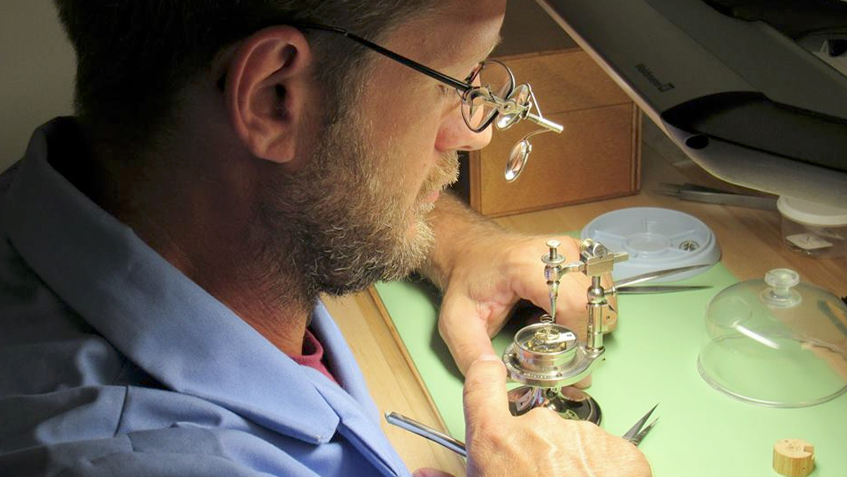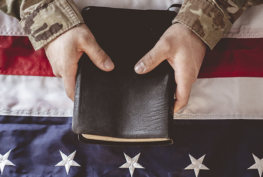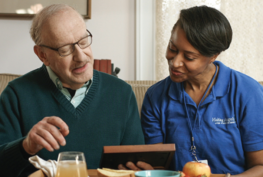by Sam Cannan, Chairman of the Board of Veterans Watchmaker Initiative, Inc
Welcoming the Educational Opportunities and Jobs Provided by the Veteran’s Watchmaker Initiative, Inc. to 307 Sixth Street in the quiet, historic suburb of Odessa, Delaware, houses the country’s lone “Veteran’s only” technical school. The Veteran’s Watchmaker Initiative, Inc., provides for, as its focus, disabled veterans, with a valuable and highly sought-after skill—horology, otherwise known as watchmaking; a skill that has all but disappeared due to attrition of the work force through retirement or death.
The donated former EMT building in Odessa draws no attention, located in this sleepy, quiet town, nor does it show a flashy sign to passersby. The light comes from within this treasure-a special class of students, the school’s first class ever to prepare to graduate. Every one of the students in these specialized halls are disabled American Veterans; they all are learning a skill that can be used to change the shapes of their lives. As a horologist, the veteran will be able to work anywhere in the world for a very respectable salary.
On Wednesday, September 12, 2017, a monumental and groundbreaking occurrence for American’s Veterans took place: the opening of the Veteran’s Watchmaker Initiative (VWI). The VWI is the first of its kind in two ways; first, it is the only American technical school specifically for American veterans, and second, this in statute of learning is the only watchmaker school that accepts by default, only honorably discharged American Armed Forces Veterans.
Building in Odessa, as the first stage of the school, is sweetened by the fact that two of the most famous watchmakers of all time: John Janvier Sr., and Scottish immigrant, Duncan Beard (who specialized in tall-case clocks) lived and worked in this unassuming town during the mid- to late 1700’s, making it the Colonial hub for watchmaking.
The Watchmaker program not only prepares our veteran graduates to make a watch from what seems an incredible number of parts, but it also bestows the title of micro-machinist, says Sam Cannan, Chairman of the Board, Director and instructor at the VWI, “[after training]…any part they need, they can create from scratch, which is the hallmark of a watchmaker.”1 There is a second program currently in place at the school, quartz repair technician, an intense 6-week program that will leave any participant ready to enter the job market as a watch technician at any jewelry counter.
The VWI program is modeled after the 1946 Bulova Watch Company program, that both saw a need in the economy, and a need to service our disabled veterans who had fought in WWII at the same time. These Bulova trained workers are some of the very last watchmakers in the world. Of approximately 2800 watchmakers worldwide, the industry lost over 300 workers last year to death or retirement.
Overseas companies are scrambling to build millions of dollars’ worth of schools that might, if lucky, graduate 7 or 8 students every 2 years. Overkill? Perhaps not. In recent years, high end, mechanical time pieces have been making a comeback. New watches as well as collectable pieces, family heirlooms and timeless designs have begun, once again, to pulse with the rhythm of today’s enterprise. And so, there is a need for trained watchmakers-masters of a craft that at one time, and that very recently, had all but died away.
But here, following the Bulova model, Cannan has renewed interest in the profession, if the 300+ people who are on the waiting list are to be believed. With a classroom size of only 6 to 7 students at a time, the ratio of student to teacher is 3:1, and will remain at that approximation with each new stage of growth of the program through its new location and housing. The level of education that comes from such a small class size is staggering to imagine. Not only will the veterans be ready for employment, these students will be actively sought by different companies, their highly specialized training more than preparing them to enter the worldwide workforce once more.
Sam Cannan states, “The focus of our program is to teach our war veterans, especially disabled veterans, the highly skilled art of watchmaking. We are the only technical school devoted to disabled veterans in the USA. All our programs are free of charge to the veteran. By starting this initiative, we hope to repay the sacrifice and service of our veterans by teaching them a skilled profession (using state-of the-art equipment) that is in high demand and well-paying.”
Cannan has improved on the original Bulova family’s program. First, only honorably discharged veterans can get into the VWI technical school. Ever. Emphasis on admissions goes to those vets who are service disabled, and they get precedence for any class. Second, this education is completely free to the veterans who are in the program. The school, when completed will be 4-acres with a 28,000 sq./ft. main campus with housing for up to 54 full-time residents. On site at the Middletown campus will be a cafeteria, gym, chapel, and other amenities when it is built.
In the future, the school plans on opening a class on jewelry repair. To this end, and to triple the current class size, building construction has begun to remove the ambulance bay doors and give the ambulance dock cum storage area a makeover into a new, larger watchmaking lab, a jewelry repair lab and two smaller workshops. This construction was to have started during the week of July 9th, but scheduling problems arose. For the Middletown campus, there have been several town meetings, go a-heads and hold ups from the town that are currently working toward resolution. Hopefully, with donations to yet be received, the ground will be able to be broken soon and the campus built, serving up to 54 veteran students at a time.
The largest need now is for three essential pieces of equipment, setting up temporary housing in Middletown, and for the campus construction in Middletown. When Middletown opens its doors, the former EMT hall in Odessa will become a workshop for graduates of the program. At that time, graduates who choose to pursue their profession, but not work in a public setting for whatever reason, will be able to work from their new closed-door facility.




